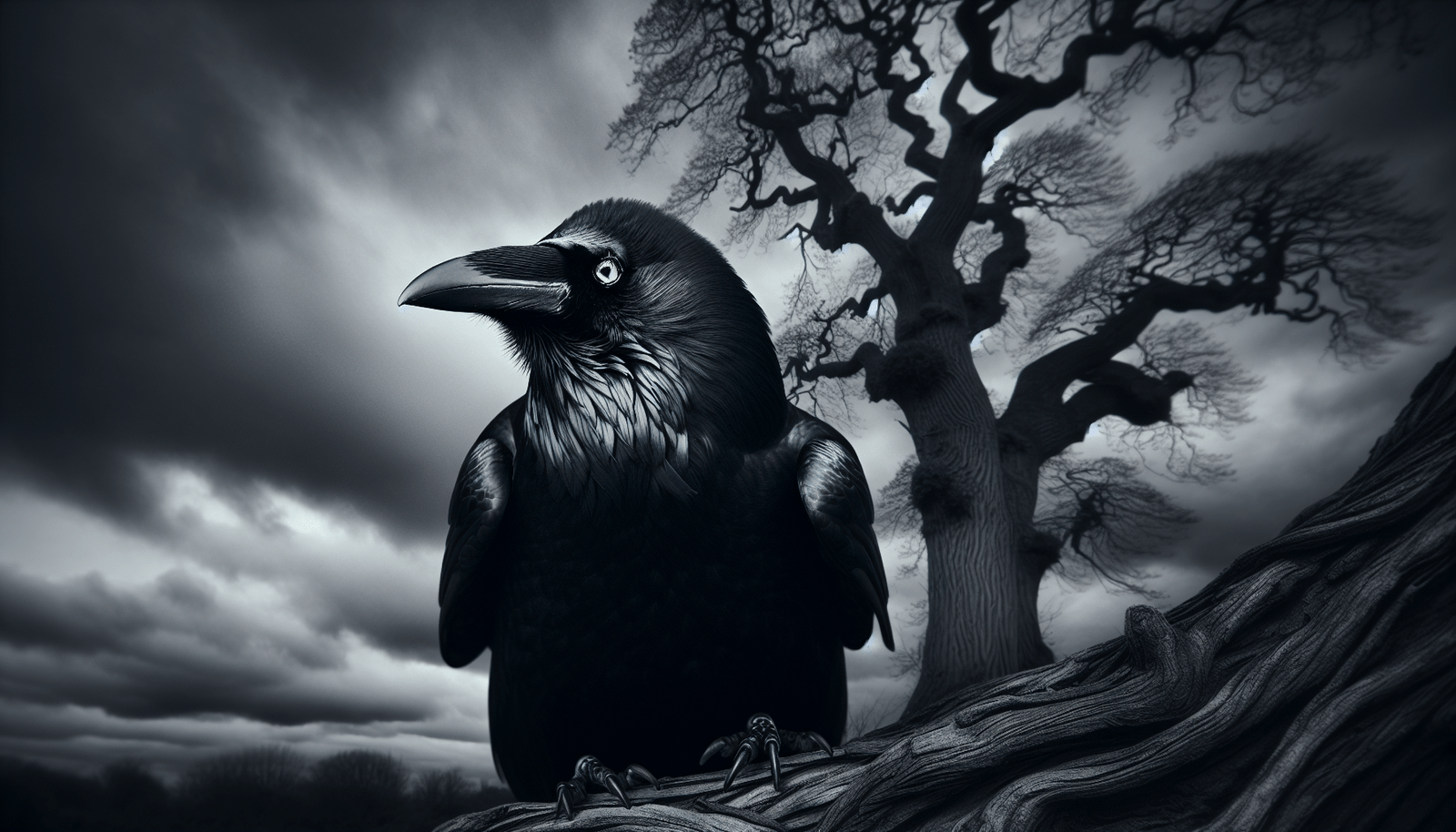Meet Corvus Fossilis: The Extraordinary Fossilized Blackcrow of Seveckenberg
December 30, 2023 | by BlackCrow.com

The Extraordinary Blackcrow of Seveckenberg
Introducing Corvus Fossilis
Meet Corvus Fossilis, an extraordinary fossilized blackcrow that has captured the attention of paleontologists and bird enthusiasts alike. Believed to be from the late Pleistocene era, this fossil was discovered in Seveckenberg, Germany. While it is classified as Corvus Fossilis, it is likely a subspecies of Corvus Corax, the common raven.
Corvus Fossilis provides a unique opportunity to study the ancient avian world and gain insights into the evolution of crows. This remarkable find has shed light on the prehistoric environment and the diverse range of bird species that once inhabited the area.
The Fascinating Fossil Discovery
The discovery of Corvus Fossilis has captivated scientists due to its exceptional preservation and the information it reveals about prehistoric avian life. Fossils like these offer a glimpse into the distant past and provide valuable data for understanding the evolution of birds.
The fossilized blackcrow was unearthed through meticulous excavation and careful handling. Paleontologists have analyzed the remains to determine its age, characteristics, and possible subspecies. The findings from this fossil contribute to the growing body of knowledge about avian evolution and the history of our planet.
As we continue to explore the world of paleontology, discoveries like Corvus Fossilis remind us of the incredible diversity of life that has existed throughout Earth’s history. They inspire curiosity and wonder, fueling our desire to learn more about the ancient creatures that once roamed the Earth.
Stay tuned as we delve deeper into the story behind Corvus Fossilis and unravel the significance and implications of this extraordinary find.
The Story Behind Corvus Fossilis
The Late Pleistocene Era
Corvus Fossilis is an extraordinary discovery from the Late Pleistocene era, which occurred around 126,000 to 11,700 years ago. This period is known for its significant climatic changes and the emergence of various species. The Late Pleistocene era was characterized by the presence of large ice sheets, extensive glaciation, and the eventual retreat of the ice as the Earth transitioned into the Holocene epoch.
During this time, the Seveckenberg region in Germany was home to diverse flora and fauna. It was in this ancient landscape that the fossilized remains of Corvus Fossilis, a blackcrow, were found. This remarkable find has provided valuable insights into the avian species that inhabited the area during the Late Pleistocene era.
Uncovering the Fossilized Blackcrow
The discovery of Corvus Fossilis was a result of meticulous excavation and paleontological research. Fossils are the preserved remains or traces of organisms that lived in the past, and they offer us a glimpse into the history of life on Earth.
The fossilized blackcrow was unearthed in the Seveckenberg region, where paleontologists meticulously excavated the site. The fossilized remains of Corvus Fossilis were carefully extracted from the surrounding sediment and transported to a laboratory for further examination.
Paleontologists studied the fossil to determine its age, species, and characteristics. Through a combination of anatomical analysis and comparison to existing avian species, they identified Corvus Fossilis as a probable subspecies of Corvus Corax, the common raven.
The fossilized blackcrow provides a unique window into the past, allowing scientists to better understand the avian population and environmental conditions during the Late Pleistocene era. This discovery contributes to our knowledge of avian evolution and the prehistoric environment that shaped the world we know today.
Unveiling the Characteristics
As we delve deeper into the extraordinary blackcrow of Seveckenberg, known as Corvus Fossilis, it is important to uncover the unique characteristics that make it truly remarkable. Let’s explore the physical features of Corvus Fossilis and discuss its probable subspecies within the Corvus Corax species.
Physical Features of Corvus Fossilis
Corvus Fossilis, as a fossilized blackcrow, provides us with valuable insights into the ancient avian world. Although no living specimen is available for direct observation, paleontologists have meticulously studied the fossil remains to determine its physical features.
The size of Corvus Fossilis is estimated to be similar to that of its modern-day counterpart, the common raven (Corvus Corax). With a wingspan of approximately 120-150 cm (47-59 inches) and a length of around 60 cm (24 inches), this prehistoric blackcrow was a formidable bird.
While the exact plumage coloration cannot be determined from the fossils, it is speculated that Corvus Fossilis possessed dark feathers, similar to the black plumage of the modern raven. This coloration would have provided excellent camouflage in its natural habitat.
Probable Subspecies of Corvus Corax
Based on the characteristics exhibited by Corvus Fossilis, it is believed to be a probable subspecies of Corvus Corax, the common raven. Subspecies within the Corvus Corax species are known for their regional variations in physical traits and vocalizations. However, further research and analysis are necessary to confirm this hypothesis.
Corvus Corax itself encompasses a wide range of subspecies found across different geographical regions. Some notable subspecies include the pied crow (Corvus albus) found in central African coasts to southern Africa, the little crow (Corvus bennetti) native to Australia, and the cape crow or cape rook (Corvus capensis) found in eastern and southern Africa. Each subspecies possesses its own unique characteristics and adaptations to their respective environments.
Corvus Fossilis serves as a fascinating glimpse into the evolutionary history of the blackcrow family. While its physical features align closely with the common raven, more research and discoveries are needed to unravel the complete story of this extraordinary fossilized blackcrow.
Continue reading to uncover the significance and implications of Corvus Fossilis, shedding light on avian evolution and the prehistoric environment.
Significance and Implications
The discovery of Corvus Fossilis, the fossilized Blackcrow of Seveckenberg, holds great significance in our understanding of avian evolution and the prehistoric environment. Let’s explore the insights gained from this extraordinary find.
Insights into Avian Evolution
Corvus Fossilis provides valuable insights into the evolution of avian species, particularly the Blackcrow family (Corvus Corax). Through the study of its fossilized remains, scientists can analyze the physical characteristics and adaptations of this ancient bird. By comparing these features to those of modern-day Blackcrow subspecies, such as Corvus Brachyrhynchos and Corvus Cornix, we can gain a deeper understanding of their evolutionary history.
Studying the ancestral characteristics of Corvus Fossilis allows scientists to trace the lineage and evolutionary changes that have occurred over time. This knowledge helps us piece together the puzzle of how the Blackcrow species has adapted, diversified, and spread across different regions of the world. By studying the ancient past, we can better comprehend the present diversity and distribution of Blackcrows.
Understanding the Prehistoric Environment
The fossilized remains of Corvus Fossilis provide a window into the prehistoric environment in which it lived. By analyzing the geological context and associated fossil assemblages, scientists can reconstruct the ecosystem and understand the ecological interactions that shaped the lives of these ancient birds.
The late Pleistocene era, during which Corvus Fossilis thrived, was marked by significant climatic changes. By examining the fossil record and sediment layers, scientists can gather information about the vegetation, climate, and other environmental factors that influenced the existence and distribution of Blackcrows during that time. This knowledge helps us understand the ecological dynamics and adaptations of Blackcrows in response to environmental change.
Studying the prehistoric environment not only enhances our understanding of the past but also provides valuable insights into the potential impacts of environmental changes on present-day bird populations. It highlights the resilience and adaptability of Blackcrows throughout history and emphasizes the importance of preserving their habitats to ensure their continued survival.
The discovery of Corvus Fossilis opens up new avenues for scientific inquiry and fuels our curiosity about the natural world. By engaging children with this fascinating fossil find, we can inspire a love for paleontology and encourage them to explore the wonders of our planet’s rich history.
Curiosity and wonder are the driving forces behind scientific discovery, and Corvus Fossilis exemplifies the excitement and endless possibilities. Let’s continue to celebrate and explore our natural history, unlocking the secrets of the past and gaining a deeper appreciation for the diversity of life on Earth.
Inspiring Curiosity and Wonder
The discovery of Corvus Fossilis, the extraordinary fossilized blackcrow of Seveckenberg, has captured the imagination of both scientists and enthusiasts alike. This remarkable find not only provides valuable insights into avian evolution and the prehistoric environment but also serves as an excellent opportunity to inspire curiosity and wonder, especially among children.
Engaging Children with Corvus Fossilis
Corvus Fossilis offers a unique chance to spark children’s interest in paleontology and the natural world. By learning about this ancient blackcrow, children can develop a deeper appreciation for the diversity of life that existed long before our time. Here are a few engaging ways to introduce Corvus Fossilis to children:
- Storytelling and Imaginative Play: Create a fictional story or scenario around the life of Corvus Fossilis. Encourage children to use their imagination and act out scenes involving this ancient blackcrow. This interactive approach can stimulate their creativity and foster a love for learning.
- Hands-on Activities: Organize hands-on activities, such as fossil excavation simulations or creating replica fossils using modeling clay. These activities allow children to experience the thrill of discovery and understand the process of uncovering fossils.
- Art and Crafts: Encourage children to express their creativity by drawing or painting their interpretation of Corvus Fossilis. This can serve as an opportunity to discuss the importance of preserving fossils and the role of paleontologists in studying ancient life.
Encouraging a Love for Paleontology
Corvus Fossilis can serve as a gateway to cultivating a love for paleontology in children. Here are a few additional ways to nurture their interest:
- Museum Visits: Take children to natural history museums or exhibitions that feature fossils and paleontological displays. Exploring these exhibits can provide a tangible connection to the world of paleontology and ignite their curiosity.
- Books and Educational Resources: Introduce children to age-appropriate books, documentaries, or online resources that delve into the wonders of paleontology. These resources can offer fascinating insights into the world of fossils, dinosaurs, and ancient creatures.
- Outdoor Excursions: Organize field trips to fossil-rich areas or nature reserves where children can participate in guided fossil hunts or learn about local geology. This hands-on experience allows them to connect with nature and develop a deeper understanding of the world around them.
By engaging children with Corvus Fossilis and the broader field of paleontology, we can inspire a sense of wonder and curiosity about the natural world. Encouraging their love for paleontology may not only lead to a lifelong passion for scientific discovery but also foster an appreciation for the importance of preserving our planet’s rich history.
RELATED POSTS
View all


